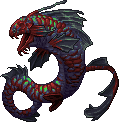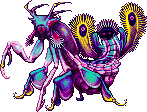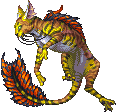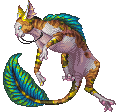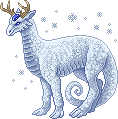 x
x 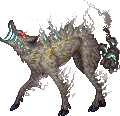
So my idea for this guy is that it relies on people mistaking it for an Icist and wandering close enough for it to attack, but they also inherited the Icist's limit for only eating frozen stuff, so it prefers to grab people by the soul and drag them out into the cold until they freeze so that it can eat their bodies after they drain the person's energy like their cerverid parent. The best way to stay safe from them is to recognize the ways they are different from icists: they are smaller in size and have shorter necks, their wool is a slightly more grey in color, their heads are more deer-like, their back feet end in hooves, and the gem on their forehead is black instead of blue. They probably hibernate during the summer or something.
Egg:
Spoiler

This round egg is so cold it makes your hands numb the instant you touch it.
Hatchling:
Spoiler

These hatchlings are covered in a soft, downy wool that is very tempting to touch and adds to their helpless appearance. A magi should use caution when approaching one, however, as this guise is used in the wild to draw would-be predators to them who, in turn, become prey. These hatchlings do not have the power over other beings the way adults do and cannot force them to stay nearby, meaning their target may still escape. Because of this, young Permafrost Stalkers supplement the life force they steal with snow and ice like their Icist relatives.
Adult:
Spoiler

When a Permafrost Stalker is fully grown, it abandons it's secondary food source of ice and snow almost completely. They endlessly follow the migration routes of Icists, relying on their similar appearance to draw in unsuspecting prey. Like their Cerverid parent, these creatures also consume the bodies of the victims whose life forces they drain, but they can only do this if said body is frozen. Because of this, a common tactic found in hunting Permafrost Stalkers is to first bind themselves to a host, and then force the host to follow them through the cold tundra until the host freezes to death. An experienced Permafrost Stalker may bind itself to several targets and force all of them to follow it, and it is thought by many that these additional targets are brought to others of their kind or possibly to the creature's Cerverid parent. No one has dared to risk following one.
Spoiler
Those who live in the areas Icists dwell have long-standing traditions of never visiting the herds at night. Stories are told of False Icists with deer-like faces, smaller statures, and black gems on their foreheads. These stories and traditions are meant to keep these people safe from Permafrost Stalkers, and the caution is not unfounded as the creatures can and will attack humans without a second thought. Many villages will keep count of the number of creatures making up nearby Icist herds, and if the numbers drop by three or more, it is a good sign a wild Cerverid parent has used its illusory magic to infiltrate the herd to protect and collect its offspring. Many believe that the wild Permafrost Stalker's Icist parent disappears after meeting an unfortunate end.



